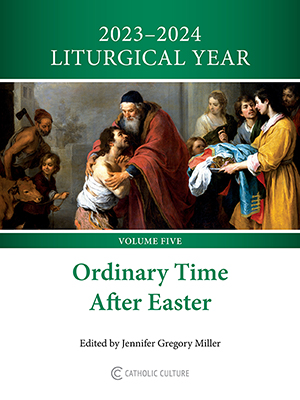spiritual liberty & the language of ritual
By Diogenes ( articles ) | Jun 03, 2006
Free eBook:

|
| Free eBook: Liturgical Year 2023-2024, Vol. 5 |
A couple weeks ago I tried to show how Bishop Donald Trautman's objections to the language of the new translation of the Roman Missal were misplaced. In a word, he blamed the translators for not giving us the Bible, when their job was to give us the Mass. Allyson Smith's re-cap of the L.A. Religious Education Congress includes further remarks by Trautman that deserve comment:
Trautman addressed another proposed change to the first Eucharistic Prayer -- from "cup" to "precious chalice." Said Trautman: "'precious chalice' -- when I hear those words, I think of a gold vessel with diamonds on it. Did Jesus, at the Last Supper, use a precious chalice or a cup? The gospels clearly say 'cup,' but even in the lectionary from Rome we have the word 'chalice' imposed on the inspired text to carry out this 'sacred language.'"
When the Church, in her Missal, says "taking this precious chalice into his holy and venerable hands" (accipiens et hunc praeclarum calicem in sanctas et venerabiles manus suas), is she really inviting us to imagine that Jesus used a gem-encrusted goblet at the Last Supper?
Of course not. The chalice Jesus used is not "precious" because it was bejeweled or made of gold but because it contained the Blood of our Redemption. It is the Church's contemplative understanding of the unique value of this redemption that prompts her, in awe and thanksgiving, to call the chalice praeclarus. It holds, and allows us to partake of, that blood by which our redemption was achieved.
The Institution Narrative recounted at Mass is not a mere transcription or bare-bones synthesis of the Bible. Rather, the Narrative has been given a ritual form expressed in ritual language, and as such reflects the biblical accounts as they have been reshaped by traditions of prayer, worship, spiritual converse, and theological reflection.
Does this ritual language differ from the language of the New Testament? It does. It should. The Bible gives us the story in stark narrative terms. The Eucharistic Liturgy re-tells that story in a way that foregrounds its spiritual meanings -- yet not all spiritual meanings, only those proper to one particular ritual of sacrifice and thanksgiving. Though rooted in the Last Supper narrative in the narrow sense, its diction, imagery, and emphasis ultimately derive from the whole of Scripture, New Testament and Old. Prophecy, history, psalmody, and proverbial wisdom -- all appropriated and transfigured by the worshiping Church -- are among its tributaries.
Think of a newspaper story telling how, by a fluke, a soldier's dog-tags deflected a bullet aimed at his heart and so saved his life. Think of how the same soldier, thirty years later, might speak of the dog-tags when he shows them off to his grandchildren: "Take a look at these beauties: best body armor ever made." He's not deluded about the cheap stamped metal in his hand. He's not denying or correcting or imposing an agenda on the original newspaper account. He's giving voice to "emotion recollected in tranquility." Yet the Church's language reflects not one man's private contemplation but the spiritual patrimony of centuries of believers, guided and shaped by the Holy Spirit into a public and ecclesial form.
The fact is that many people, including some Catholic clergy, don't understand rite, and are put off by ritual action and language. In the years following the Council many were enraptured by the image of the Protestant minister, seated on the lawn with a Bible open on her lap, reading and expounding God's word in Pauline simplicity. By contrast, incense and Gothic vaulting and liturgy itself seemed, to them, impure and pointless impositions on the real thing (whence "imposed" is a frequent term in their polemics). Many dealt with their distaste for rite by enacting the Eucharist as if it were theatre, or Bible study, or a family picnic: occasions more friendly and familiar to their training and sensibilities.
But we can also see lingering traces of an antipathy to rite that goes beyond distaste and becomes active resentment. Many churchmen find noxious that character of the Roman Ritual which Cardinal Ratzinger, in his book Feast of Faith, singles out for esteem:
The obligatory character of the essential parts of the Liturgy also guarantees the true freedom of the faithful: it makes sure that they are not victims of something fabricated by an individual or a group, that they are sharing in the same Liturgy that binds the priest, the bishop and the pope.
As no one is above the law, no one is above the liturgy. And that's bad news for a lot of professional Catholics convinced they have a clearer idea than the Church herself of how the Church should pray, should teach, should worship. Authentic liturgy, as the document of that name makes plain, lets the Church speak in her own voice and protects the faithful from the self-credentialed sophists. No wonder they detest it.
All comments are moderated. To lighten our editing burden, only current donors are allowed to Sound Off. If you are a current donor, log in to see the comment form; otherwise please support our work, and Sound Off!







